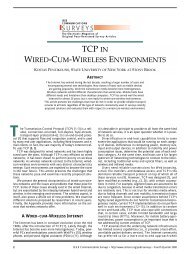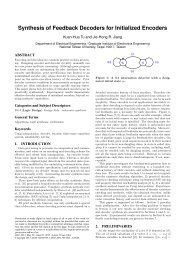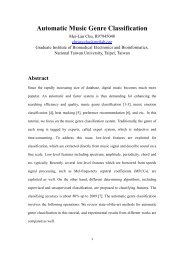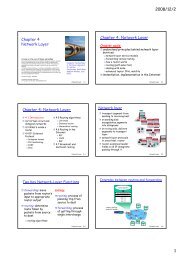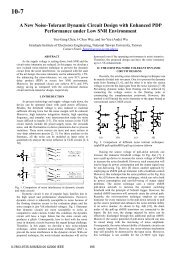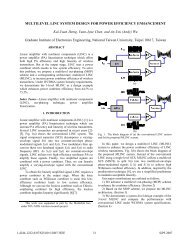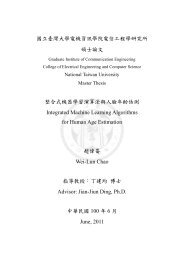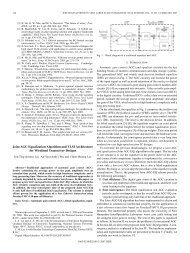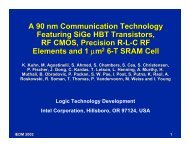Area-Efficient VLSI Design of ReedâSolomon ... - Access IC Lab
Area-Efficient VLSI Design of ReedâSolomon ... - Access IC Lab
Area-Efficient VLSI Design of ReedâSolomon ... - Access IC Lab
Create successful ePaper yourself
Turn your PDF publications into a flip-book with our unique Google optimized e-Paper software.
1246 IEEE TRANSACTIONS ON CIRCUITS AND SYSTEMS—II: EXPRESS BRIEFS, VOL. 53, NO. 11, NOVEMBER 2006presents the proposed JIT-FMEA scheme. Section IV showsthe proposed area-efficient RS decoding architecture. Thecomparison results are discussed in Section V. Finally, theconclusions are given in Section VI.II. DRAWBACK OF EXISTING RS DECODING ARCHITECTURESThe syndrome-based RS decoding scheme consists <strong>of</strong> threecomponents, namely: 1) the syndrome calculator (SC); 2) thekey equation solver (KES); and 3) the error corrector (EC), asshown in Fig. 1(a) [4]. In addition, a delay buffer is usually usedto buffer the received symbols according to the latency <strong>of</strong> thesecomponents.Since KES involves the highest computational complexity <strong>of</strong>the RS decoding procedure, it affects the speed and hardwarecomplexity <strong>of</strong> the RS decoders. Hence, the throughput bottleneckin an RS decoder is in the KES block. Other blocks <strong>of</strong> theRS decoder can be simply pipelined due to their feedforwardstructures. To meet the optical rate requirement, the target RSdecoder needs to provide two design features—high data processingrate but at low hardware complexity.A. Problem in Fully Parallel MEA ArchitectureTo achieve high data processing rate, many RS decoders employthe pipeline and/or parallel architecture to improve thethroughput rate. For example, the designs in [6] and [10] usethe pipelining architecture to improve the maximum operatingfrequency. However, it results in much more registers to handlethe timing matching issue, which greatly increases the latencyand hardware cost.In general, the fully parallel architecture requires cycles t<strong>of</strong>inish the modify Euclidean algorithm (MEA) to find the errorlocation polynomial and the error magnitude polynomial. However,fully parallel architectures usually employ coarse-grainprocessing elements (PEs) for KES block [11]. Therefore, implementation<strong>of</strong> the fully expanded parallel method requireslarge hardware cost and involves higher power consumption [6],[11].The timing chart <strong>of</strong> the parallel architecture is shown inFig. 2(a). As we can see, the parallel MEA architecture usesonly cycles to execute the KES operations. There are “manyidle cycles” during the decoding procedure. Consequently,the conventional parallel architecture is an inefficient method,which leads to waste <strong>of</strong> silicon area.B. Problem in Direct Folding MEA ArchitectureTo reduce hardware complexity, some RS decoders haveadopted resource sharing and/or time multiplexing schemes toreduce the hardware cost. In general, the direct folding-bymethodfinishes the KES operation incycles,which is greater than the received code length . Thetiming chart <strong>of</strong> the direct folding-by- architecture is shownin Fig. 2(b). Since the direct folding-by- method needs onemore cycle, it is not suitable for application in continuousreal-time RS decoding.Besides, there are some approaches employing the resourcesharing concept to reuse four times the parallel MEA architecturein a four-way parallel FEC decoder architecture, which canFig. 2. (a) Timing chart for the parallel architecture. (b) Timing chart <strong>of</strong> directfolding by 2t.reduce the overall hardware complexity [10], [11]. However,the resource sharing method introduces large input and outputbuffers to process the synchronous problem <strong>of</strong> four channels.Hence, both methods cause inefficient implementation problemsin area utilization and power consumption domains.Due to the disadvantages <strong>of</strong> the two existing RS decoding architectures,in this brief, we propose an area-efficient architectureto reduce hardware complexity compared with parallelismMEA architecture. The major feature <strong>of</strong> our method is the employment<strong>of</strong> the precalculation scheme (PCS) to eliminate idlecycles and reduce hardware cost as discussed below.III. PROPOSED JIT-FMEAIn general, it takes a total <strong>of</strong>cycles to useonly a single PE repeatedly executing the MEA for KES. Nevertheless,the calculation <strong>of</strong> the SC or EC blocks needs only255 cycles.For this reason, the direct folding-by- method has difficultyin meeting the timing requirement <strong>of</strong> the whole RS decoder withthe pipelining scheme. Hence, we need to reduce the number <strong>of</strong>operation cycles so that the decoding time <strong>of</strong> the KES block canbe smaller than 256 cycles.A. PCSTo eliminate the additional cycles, we employ the PCS toeliminate the first iteration <strong>of</strong> MEA. Thus, the total processingtime can be reduced from to iterations. Based on theEuclidean algorithm, we have initial conditions(1)
HSU et al.: AREA-EFF<strong>IC</strong>IENT <strong>VLSI</strong> DESIGN OF RS DECODER FOR 10GBASE-LX4 SYSTEMS 1247TABLE ISUMMARY OF THE PROPOSED JIT-FMEA ALGORITHMFig. 3. New timing chart <strong>of</strong> the JIT-FMEA algorithm. It does not have any idlecycles in the KES procedure.Since the syndrome polynomial has been calculated by theSC block, we can use it to precalculate one iteration operation<strong>of</strong> the MEA before KES easily. Hence, we can obtain the newinitial values <strong>of</strong> MEA by using the PCS method as shown at theright-hand side <strong>of</strong> (1).We can see that the new initialization values <strong>of</strong> the MEAare also the already known values from (1). Therefore, the PCSmethod can not only save one iteration from MEA but also diminishthe operating complexity and the power consumption atno increase <strong>of</strong> extra circuits.B. JIT-FMEAWe employ the regular MEA parallel architecture and fold itby times [13]. The folding architecture requires onlyhardware cost <strong>of</strong> the PE to solve the KES operation. Hence, wecan greatly reduce the total hardware cost. Nevertheless, the directfolding method causes the unsuitable pipelining architecturefor the continuous data processing. Hence, we adopted thePCS method in the folding MEA algorithm to save the first oneiteration, i.e., we can save operating cycles in the KES block.However, this method will involve idle cycles during theRS decoding procedure. Consequently, there are cyclesthat are redundant. Therefore, hardware utilization is not fullyutilized.To avoid such a problem, at each iteration operation, we employthe additional cycle to lock the leading coefficients andto ensure the correct results. Moreover, the control flow canbe implemented easily. Each iteration operation needssymbol cycles. Hence, FMEA architecture needscycles (i.e., symbols) toaccomplish the KES procedure. We call this method JIT-FMEA.It does not have any idle cycles during the RS decoding procedure.Therefore, this algorithm can provide fully hardware utilizationas compared to the conventional parallel architecture.Table I summarizes the proposed JIT-FMEA algorithm, whereFig. 4.(a) Parallel MED architecture. (b) Parallel MEM architecture.denotes an R-type register, the index denotes the iterativenumber, the index denotes the folding cycles by using thefolding architecture, and the index denotes the order number<strong>of</strong> the coefficient <strong>of</strong> the polynomial.The new timing chart <strong>of</strong> the proposed JIT-FMEA is shown inFig. 3. We can see that no idle cycles occur during the KES procedure.With the modifications, now, the decoding method canbe easily applied to 10GBase-LX4 systems, which do not requireadditional buffers at both input and output ports to handlethe synchronization problem in [11].IV. FOLDED JIT-FMEA <strong>VLSI</strong> ARCHITECTUREIn [13], we have proposed a scalable parallel MEA architecture,as shown in Fig. 4. It can be easily folded by . Moreover,according to the JIT-FMEA algorithm, we can easily constructthe regular data path for the JIT-FMEA architecture, as shown inFig. 5. The control flow <strong>of</strong> the JIT-FMEA architecture is shownin Fig. 6.The JIT-FMEA algorithm consists <strong>of</strong> two major operations:One is the RQ part for the modified Euclidean division (MED)operation. It performs the long division operation to obtain theerror magnitude polynomial . The other is the LU part forthe modified Euclidean multiplication (MEM) operation. It performsthe multiplication and accumulation in the polynomialdomain. It is used to obtain the error location polynomial .Moreover, the equations in Table I describe the data path controlflow. The KES operation can be separated into two modes:


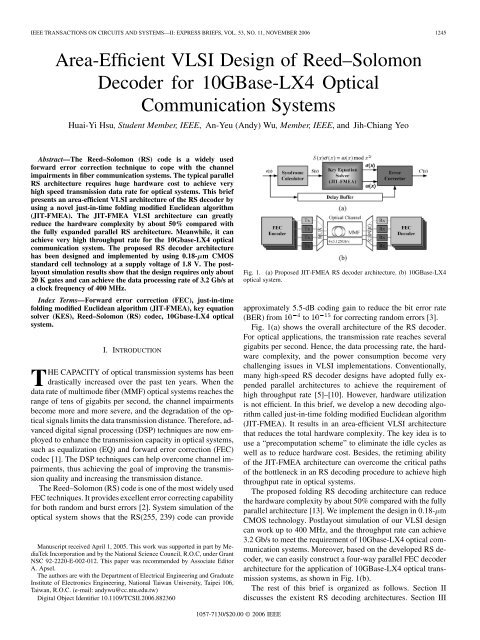
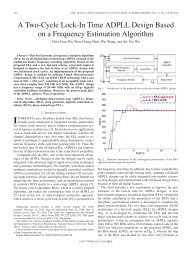
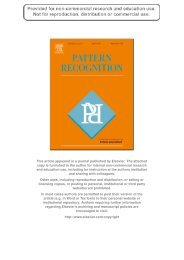
![On [n, n - 1] convolutional codes with low trellis complexity ...](https://img.yumpu.com/45854741/1/190x245/on-n-n-1-convolutional-codes-with-low-trellis-complexity-.jpg?quality=85)
